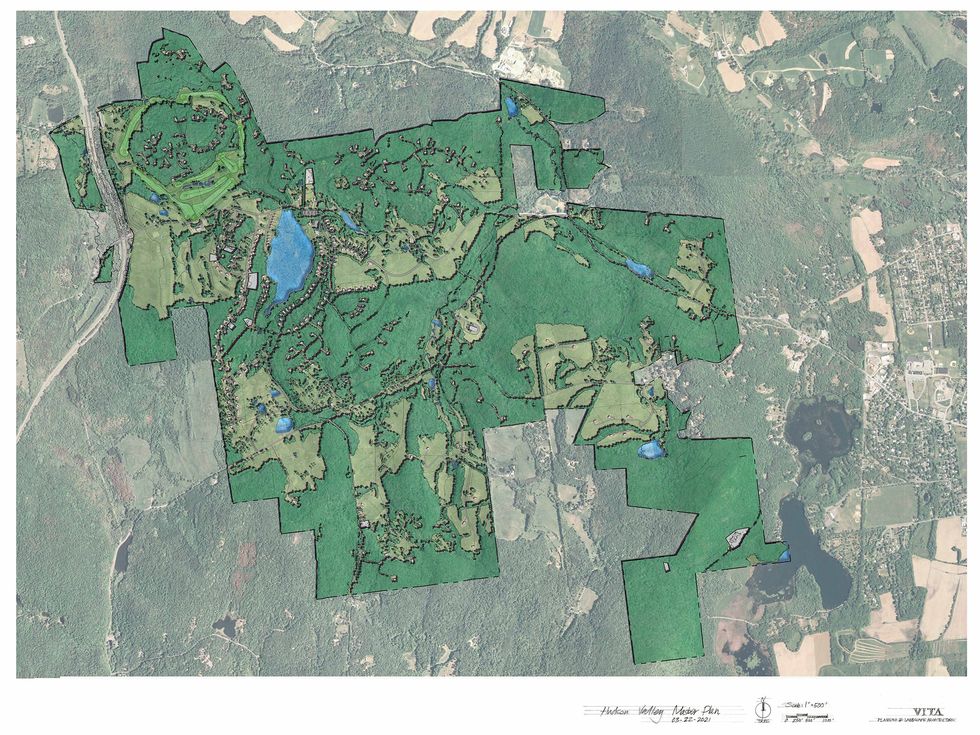PINE PLAINS — After receiving The Durst Organization’s latest application for the Hudson Valley project (formerly known as the Durst project) in Pine Plains and Milan, the Pine Plains Planning Board discussed the application and what steps should be taken going forward at its meeting on Wednesday, April 14.
Conservation subdivision
The Durst Organization submitted an application to the board on Wednesday, April 7, that proposed a 237-lot conservation subdivision on its 2,655-acre property west of the main hamlet of Pine Plains. As part of its proposal, Durst requested in its proposal that the board begin both the sketch plan review of the subdivision and the required State Environmental Quality Review Act (SEQRA) process and begin circulating for lead agency.
Included in the SEQRA process, a new Draft Environmental Impact Statement (DEIS) will be prepared to review the project.
The meeting was held over Zoom and live streamed to the “Pine Plains Planning and Zoning Boards” YouTube channel due to the COVID-19 health crisis. Durst Project Manager Lisa Baker introduced a few team members, including attorney Jennifer Van Tuyl, project manager Catherine Monian and planner Stuart Mesinger from The Chazen Companies.
Baker outlined their intent to present the residential sketch plan The Durst Organization submitted to the board for the proposed conservation subdivision redevelopment of the former Carvel Country Club and its adjoining properties. Although it’s been almost a year since they last presented to the Planning Board, she said the team has been “working continuously to consider the best project imaginable for this beautiful property.
“We look forward to working closely with your board and the Milan Planning Board to create a project that preserves a substantial amount of open space, protects environmental resources, supports local economic activity and preserves connectivity to the hamlet and adjoining recreational resources,” Baker said.
Past plans
Monian projected an overview of the project site as a visual for Mesinger’s review of the project’s history. From the development of the late ice cream magnate Tom Carvel’s original plan for the property in the 1960s to Durst’s acquisition of Carvel’s golf club in 2001, Mesinger covered pivotal moments for the property as well as the various alterations made to the project over the past two-plus decades.
He also touched on Durst’s application for a second-home community project in 2004 and its 2011 application under Pine Plains’ New Neighborhood Development (NND) provisions to develop a new neighborhood district.
Mesinger said Durst studied conservation subdivisions closely before deciding to advance a new project. The organization formally withdrew the NND application and held a public meeting to discuss the conservation subdivision concept last February; by April, a pre-sketch application for the conservation subdivision concept was submitted to the board.
Mesinger reminded the board that the purpose of the pre-sketch process is two-fold: to establish a base residential yield for how many units can be developed on the property and to establish at least 50% of the site as open space as required by the conservation subdivision process.
Monian projected the pre-sketch plan that outlined the various conservation features mapped on site; 53% of the site was identified as open space and the calculation for the base residential yield came out with 223 units. In addition to submitting the conservation subdivision application to the Pine Plains Planning Board, Mesinger said Durst met with the Milan Planning Board to present the concept and talk about the development process.
They also met with the New York State Department of Health to talk about water and sewer, and are now trying to schedule a meeting with the New York State Department of Environmental Conservation (DEC) to talk about issues that might fall under its jurisdiction.
Open space
Looking at the sketch plan application itself, Mesinger pointed out key features, such as how the plan respects the buffers around the regulated wetlands and limits road crossings. However, he said he believes the plan’s most salient feature is the amount of open space. With the base residential yield calculated at 237 lots (11.2 acres per lot), the development is largely focused on Lake Carvel and north and west of Route 199. Because Durst is considering a resort in Pine Plains, Mesinger said they’d like to have the resort be an alternative to be considered in the project’s DEIS.
Planners Frank Fish and Sarah Yackel from BFJ Planning, planning consultants for the town, gave the board a preview of what steps are expected in the SEQRA process.
Fish said he believes the first action would be for the board to declare its intent to be lead agency in the SEQRA process, while Yackel walked the board though that process with its anticipated steps, meetings and scoping sessions. The board engaged in a thorough discussion both with its planners and Attorney to the Town Warren Replansky in terms of how the resort alternative would work.
Working with Milan
Planning Board member Dick Hermans asked if the board should set up a formal liaison with Milan to stay abreast of Milan’s side of the project. The board agreed it was a good idea to have a Pine Plains liaison attend Milan’s meetings and designated Hermans to be the liaison.
Replansky said he believed the Planning Board is obligated to conduct a coordinated SEQRA review with Milan. As he’s anticipating that there’s going to be much more coordination between the two municipalities during the review of this project, he said the bard should start thinking in terms of how it will do that.









 Submitted
Submitted






